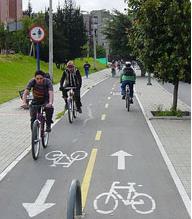What is it?
The CicloRuta is a network of 211 miles (303km) of bicycle only transport lanes. After a few examples of built lines between 1996 and 1997 (a few km during the Antanas Mockus administration, a formal plan was structured and extensively implemented all around the city by Mayor Enrique Peñalosa who has a personal commitment to a healthy, car-free city. He proposed that urban planners "make sidewalks as wide as you value your citizens".
The CircloRuta facilitates 213,000 trips (2005) a day although at present it might be helping to produce 320,000 trips (4% of the more than 8 million trips made in Bogota), and accounts for 83,000 people (1.2% of the whole population). When the project began about 0.2% of the trips were made by bike.
How does it work?
The system is divided into three sections:
1. The Main Network: connects the key city centres – its main educational and work areas - with the most populated residential areas. It also connects with the secondary network. These lines are surroundings the more important road axes that they link the great city center with more the densely populated areas; axes cross-sectional and in the road axes that cross the city of North to the South; axes longitudinal. Phase II of TransMilenio includes as part of its design CicloRutas along several trunk lines.
2. Secondary Network: connects housing areas, parks and facilities and attractions with the main network. These paths are mostly designed to serve as feeders to TransMilenio. All main head and stations of TransMilenio have guarded bike parking facilities.
3. Complementary Network: this links recreational networks, and external routes to the system. These paths are located along the river banks which in turn are part of the system of Linear Parks of the City; some are surrounding wetlands too.
C02 emissions reductions
Annual reductions for 2007 were 6,449t CO2e, based on 7% of CicloRutes users leaving their cars at home, distance traveled and fuels used.
Costs
340km of the CicloRuta network was built by the City Administration with its public investment budget. The city has spent:
* In studies and initial designs: US$250,000
* In construction: US$50 million
* The direct investment cost per km built is nearly US$ 147,000.
Annual Savings
* Monthly saving by person USD $40
* Annual saving by person: $480
Annual Running costs
* Maintenance is made basically to the accesses at the bike paths edges, every 6 months, for US$ 0.60/m2 (this includes sealing).
* Every two years thermal painting is applied at a cost of US$32.5/m
Next steps
At present projections are that a complete network of 500 km will be completed by 2010. In year 2007, 13 more kms will be ready.
Results
Since the beginning of the construction of the CicloRuta in 2000:
1. Bicycle use has increased from 0.2% in 2000 to 4% in 2007 of the total trips in the City.
2. This means up to 320,000 trips made daily within Bogotá
3. The use of bikes in CicloRutas has increased from 22,700 to 83,500 bikers, meaning a 268% increase in 7 years or 38% per year.
4. CicloRutas play an important role for the poor people of the City. As in the following graphic can be seen, more than 23% of the trips made by the lowest income group in the city are pedestrian and by bikes. As the income level rises, there are less people walking or biking.
5. Air quality improvement is helped with the use of CicloRutas when people leave the car at home. It was calculated for Bogota a reduction in GHG of 36.6 thousand tones of CO2e.
6. Safety in transportation is one of the issues the bikers mention in the surveys. Now they can move with reduced accident risk since the paths are away from cars, but for the intersections where most attention ought to be put. In Bogotá there has been a 335 decrease in deaths relating to bikes (from 115 in year 2001 to 77 in year 2004) , this has occurred despite the large increase in CicloRutas trips. In addition, injuries reduced 8.8% (2,754 in 2001 to 2,512 in 2004) despite a 38% increase in bike use.
7. Speed is often an interesting benefit: bikes mean speed is 17 km/h, while public non massive transport runs at 13 km/h.
8. CicloRutas also helped to recover public space, along riverbanks, and wetlands - the city’s 13 wetlands were occupied for years by illegal constructors, after construction of the CicloRutas development stopped in this precious natural environment.
Application
There are several requirements for the CicloRutas to be considered as a successful transportation option:
* political will
* independent paths from car lines
* origin-destination linked (people, especially low income groups, should find useful the CicloRutas to go to school, universities, to work;
* connection with other transportation modes
* bike parking facilities in private and public premises especially in transportation mode exchange places (if parking facilities are not available using the bike becomes a mayor problem getting in to any office or building, or changing transportation mode);
* rules for bikers, pedestrians and car owners;
* good intersections and signals;
* bridges to keep continuity and to cross wide avenues;
* Many business will grow along with CicloRutes: bike parking services, bikes and spare parts shops and production, clothing, and the like
Bogotá prepared and has available a Design Manual and Good Environmental Construction Practices guidelines for public works on its cycleway system.



